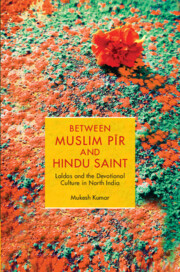Book contents
- Frontmatter
- Dedication
- Contents
- List of Figures, Maps and Tables
- Acknowledgements
- List of Abbreviations
- A Note on Transliteration
- Maps
- 1 The Spectre of Binaries
- 2 Laldas and Religious Duality of Pīr and Sant
- 3 The Laldas Shrines and Inter-religious Disputes
- 4 A Fait Accompli: The Complete Hinduisation of the Laldas Order
- 5 Religious Reform and Shared Shrines
- 6 Concealment and Secrecy: Hidden in Plain Sight
- 7 Poetic Response to Religious Puritanism
- 8 An Ephemeral Line in the Sand
- Appendices
- Glossary
- Bibliography
- Index
8 - An Ephemeral Line in the Sand
Published online by Cambridge University Press: 30 April 2024
- Frontmatter
- Dedication
- Contents
- List of Figures, Maps and Tables
- Acknowledgements
- List of Abbreviations
- A Note on Transliteration
- Maps
- 1 The Spectre of Binaries
- 2 Laldas and Religious Duality of Pīr and Sant
- 3 The Laldas Shrines and Inter-religious Disputes
- 4 A Fait Accompli: The Complete Hinduisation of the Laldas Order
- 5 Religious Reform and Shared Shrines
- 6 Concealment and Secrecy: Hidden in Plain Sight
- 7 Poetic Response to Religious Puritanism
- 8 An Ephemeral Line in the Sand
- Appendices
- Glossary
- Bibliography
- Index
Summary
In order to comprehend various interconnected aspects, such as the historical transformation of identities, shared places of worship and blended socio-religious customs, it is imperative for scholars of religion to adopt a comprehensive viewpoint that considers the dynamic nature of evolving religious cultures. Understanding the diverse religious landscape of South Asia requires going beyond rigid categorisations of ‘Hindu’ or ‘Muslim’ and instead recognising the historically embedded connections and conflicts among ‘locally’ developed religious practices. Without acknowledging these complex interrelationships, it is impossible to grasp the full extent of Indic religious diversity. Pre-existing elements of religious cultures may take different and separate routes, can mould and be moulded by social and political forces. But, despite these changes in the (re-)structuring of a new religious worldview, certain shared devotional aspects remain in vestigial forms.
When the Laldas religious order was established in the sixteenth century, it was based on various strands of ‘Sufi’ and ‘Bhakti’ doctrines that promoted the transcendence of two institutional religious identities, ‘Muslim’ and ‘Hindu’. In accordance with the teachings of the saint Kabir, Laldas formed a unique religious synthesis that gave priority to a popular expression of a distinct religiosity. The religious traditions associated with Laldas underwent a gradual transformation, eventually being categorised under a specific religious category. In this process, the concept of ‘religion’ itself, which is a dynamic and evolving network of power, also transformed its meaning. Whether it was the devotion of a ‘Sufi’ or ‘Bhakti’ saint or the creation of ‘locally’ based ‘Islamic’ and ‘Hindu’ reformist movements, they all interacted with one another in a highly intricate manner, often adopting features of their religious opponents in order to accomplish their own goals. The emergence of the Laldas order in the sixteenth century needs to be explored in this context of diverse religious trends vying to establish supremacy over each other. His teachings centred on the promotion of nonbinary identities deeply rooted in the local context of Mewat. He is revered to this day for his ability to bestow blessings and perform miracles. Studying the historical interconnections between different conceptions of ‘Sufism’ and ‘Bhakti’ allows for a clearer understanding of popular religiosity associated with Laldas, which stands in contrast to institutionalised expressions of ‘Islam’ and ‘Hinduism’.
- Type
- Chapter
- Information
- Between Muslim Pīr and Hindu SaintLaldas and the Devotional Culture in North India, pp. 218 - 234Publisher: Cambridge University PressPrint publication year: 2024
- Creative Commons
- This content is Open Access and distributed under the terms of the Creative Commons Attribution licence CC-BY-NC 4.0 https://creativecommons.org/cclicenses/



